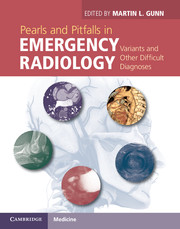Book contents
- Frontmatter
- Contents
- List of contributors
- Preface
- Acknowledgments
- Section 1 Brain, head, and neck
- Section 2 Spine
- Section 3 Thorax
- Section 4 Cardiovascular
- Case 39 Aortic pulsation artifact
- Case 40 Mediastinal widening due to non-hemorrhagic causes
- Case 41 Aortic injury with normal mediastinal width
- Case 42 Retrocrural periaortic hematoma
- Case 43 Mimicks of hemopericardium on FAST
- Case 44 Mimicks of acute thoracic aortic syndromes: aortic dissection, intramural hematoma, and penetrating aortic ulcer
- Case 45 Aortic intramural hematoma
- Case 46 Pitfalls in peripheral CT angiography
- Case 47 Breathing artifact simulating pulmonary embolism
- Case 48 Acute versus chronic pulmonary thromboembolism
- Case 49 Vascular embolization of foreign body
- Section 5 Abdomen
- Section 6 Pelvis
- Section 7 Musculoskeletal
- Section 8 Pediatrics
- Index
- References
Case 49 - Vascular embolization of foreign body
from Section 4 - Cardiovascular
Published online by Cambridge University Press: 05 March 2013
- Frontmatter
- Contents
- List of contributors
- Preface
- Acknowledgments
- Section 1 Brain, head, and neck
- Section 2 Spine
- Section 3 Thorax
- Section 4 Cardiovascular
- Case 39 Aortic pulsation artifact
- Case 40 Mediastinal widening due to non-hemorrhagic causes
- Case 41 Aortic injury with normal mediastinal width
- Case 42 Retrocrural periaortic hematoma
- Case 43 Mimicks of hemopericardium on FAST
- Case 44 Mimicks of acute thoracic aortic syndromes: aortic dissection, intramural hematoma, and penetrating aortic ulcer
- Case 45 Aortic intramural hematoma
- Case 46 Pitfalls in peripheral CT angiography
- Case 47 Breathing artifact simulating pulmonary embolism
- Case 48 Acute versus chronic pulmonary thromboembolism
- Case 49 Vascular embolization of foreign body
- Section 5 Abdomen
- Section 6 Pelvis
- Section 7 Musculoskeletal
- Section 8 Pediatrics
- Index
- References
Summary
Imaging description
Approximately 14% of aortic injuries by autopsy are caused by penetrating injuries [1]. Over 95% of these injuries are caused by knives or guns, and 90–100% of patients will die before arriving in hospital [1, 2]. In survivors, vascular embolization of a foreign body is rare, but can cause life-threatening ischemia. For a projectile to embolize in a vessel, it must be small enough and travel at sufficiently low velocity to dissipate most of its energy in soft tissues before it reaches the aorta, and penetrate just one wall of the vessel [3]. If the wall of the vessel is elastic enough, the vascular defect may close without significant exsanguination [4]. Shotgun and bullet emboli can be clinically elusive as symptoms from the embolized fragment may be absent or remote from the site of primary injury [3]. Needle embolization can also complicate intravenous drug use (Figure 49.1) [5].
Most foreign body emboli follow the direction of blood flow. They can be classified as arterial, venous, or paradoxical [6]. Systemic arterial emboli are at least twice as common as systemic venous emboli [7]. Bullets entering the ascending aorta may embolize to the great vessels supplying the head and upper extremities, whereas bullets entering the descending thoracic aorta and abdominal aorta will embolize to the abdominal viscera or lower extremities. Because the left common iliac artery has a less acute angle of origin from the abdominal aorta than the right, it has been speculated that arterial emboli are more likely to travel to the left lower extremity (Figure 49.2) [4].
Information
- Type
- Chapter
- Information
- Pearls and Pitfalls in Emergency RadiologyVariants and Other Difficult Diagnoses, pp. 162 - 164Publisher: Cambridge University PressPrint publication year: 2013
